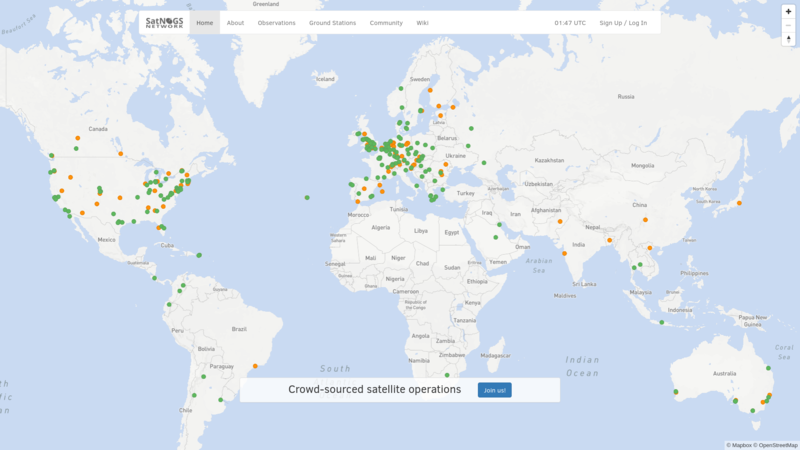Difference between revisions of "SatNOGS Network"
(Replace redirection page) |
(→Getting started: Fix url) |
||
| (One intermediate revision by one other user not shown) | |||
| Line 7: | Line 7: | ||
==Getting started== | ==Getting started== | ||
| − | * Head to https://network.satnogs.org/ | + | * Head to https://network.satnogs.org/login/auth0 to create a new account |
* Verify your email | * Verify your email | ||
Latest revision as of 18:30, 21 February 2020
Contents
Introduction
SatNOGS Network website is where the scheduling, reviewing and operations happen for the SatNOGS project. The instance can be found in network.satnogs.org
Getting started
- Head to https://network.satnogs.org/login/auth0 to create a new account
- Verify your email
Now you're ready to create a ground station!
Creating a ground station
- On your user page, click on "Add Ground Station"
- Fill out all the information. You'll need to provide some essential information about your ground station:
- Where is the station? We'll need the height above ground level and maidenhead locator
- Is the antenna static, or does it have a rotator?
- What type of antennas does the station have?
All this information is then saved by the network, and used to determine which satellites can be received by your station. This will help other users to schedule passes on your ground station, but it can also help you improve your station. For example, perhaps you would like to receive the latest NOAA APT weather images which are VHF transmissions. You could schedule an observation with your ground station and multiple other ground stations in order to determine if your set up has comparable performance. Without the station detail, this would not be possible.
- Finally, head to your client and complete its setup, using the information you supplied on the Network, plus the API key and the ID you were assigned.
The image below shows the web page for a typical ground station:
Observing a pass
The central point of the system is the ability to schedule a pass. You'll find all the information about scheduling and how to assess the quality of the observation as part of scheduling your first observation.
Your station should now appear on the Ground Stations list marked as yellow "Testing".
Moving out of testing
The Network needs reliable ground stations that perform within the constraints that would be expected. A ground station should perform in a way that is comparable to its peers and in line with the constraints of the geography, antenna type, location and the other aspects which will make a ground station different to another.
Once you feel that your station has been performing well for a period of time under the "Testing" flag then remove the flag. Select the ground station press edit and remove the testing flag under settings. Then announce the availability of a new station in our community channels!
The ground station should also be reliable. This does not mean that it should be available 24 hours a day, 7 days a week. Downtime is expected, it should however, not be unduly off line or unreliable.
What's next?
- Keep your station busy! Schedule observations or reach out to the community for scheduling help.
- Keep reviewing your ground station performance.
- Reach out to others in community for help on any issue.
Development
The SatNOGS Network application is a project by itself with constant development. We test the Network application in our development environment, and always welcome python/javascript developers to help us!

